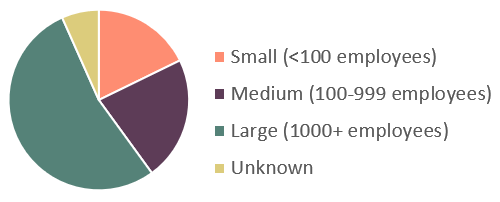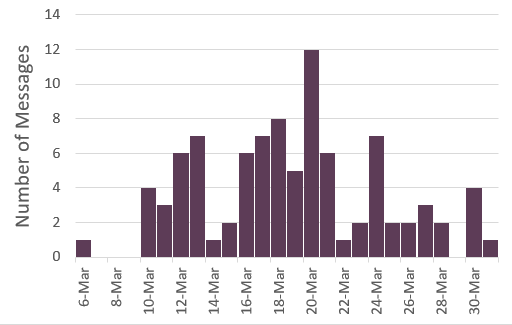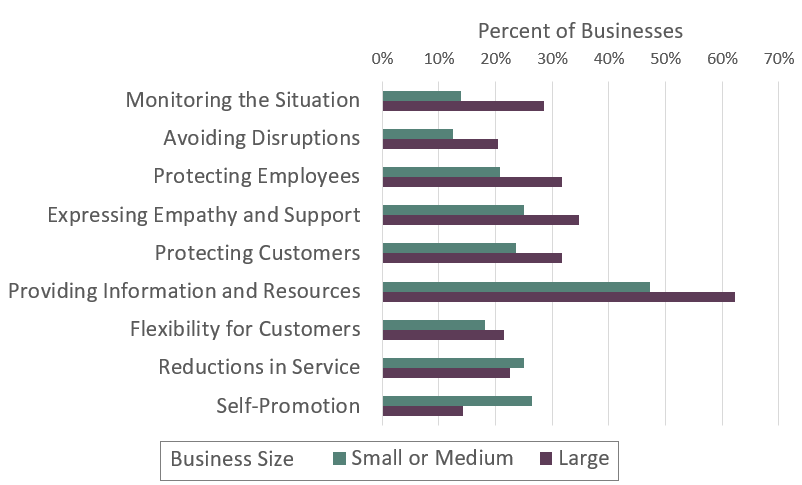Analysis of Pandemic-Related Messages
Team Members
Todd Haskell (Data Collection, Analysis, Writing)
Sophie Bird (Data Collection, Analysis)
Colton Redtfeldt (Data Collection)
Aidan Koenig (Data Collection)
Research Goals
How a business communicates with customers at the onset of a crisis can play an important role in determining how the business weathers that crisis. In the most common case, businesses are responding to an issue that affects just their company or a small number of companies. Examples would include a product defect or a data breach. The coronavirus pandemic has been rather unique in impacting essentially all businesses. For that reason, we are able to examine how a broad range of businesses chose to communicate regarding the exact same crisis, and compare and contrast those approaches.
Data Collection
The World Health Organization declared the coronavirus outbreak a pandemic on March 11th, 2020. Around that time, our team recognized that many companies were sending e-mail communications regarding the outbreak to their U.S. customers, and we began creating a database of the communications we received ourselves as well as those received by friends and family members. The final sample consists of messages from 92 different companies sent between March 6th, 2020 and March 31st, 2020. Given the way these messages were gathered, we do not claim that this is a representative sample of all businesses that sent such communications. However, as described further below, the sample is quite diverse, including both very small and very large businesses, local businesses and multinational corporations, and many different industries.
The Sample
Business Size
Businesses were classified as small, medium, or large based on number of employees. Number of employees was determined from publicly available information on the web.

Industry
For industry, we used a simplified version of NAICS categories. Example businesses for each category are provided in the table below the graph.

| Industry | Examples |
|---|---|
| Retail | Target, Discount Tire, Kay Jewelers |
| Finance and insurance | E*trade, Regence BlueShield, U.S. Bank |
| Administrative, professional, and technical services | Webroot Internet Security, UserTesting, Express Employment Professionals |
| Travel | Lyft, Hotels.com, Allegiant Air |
| Food | Buffalo Wild Wings, Starbucks, Red Lobster |
| Entertainment | StubHub, Seattle Storm, The ShakeDown |
| Education | CollegeXpress, Chess4Life, Duolingo |
| Healthcare | Quest Diagnostics, Bellingham Pediatric Dentistry, Spine and Scoliosis Clinic |
| Information | Quora, Facebook, SoundCloud |
| Telecommunications | Comcast, CenturyLink, Wave Broadband |
Primary Mode of Interacting with Customers
It was important to distinguish between companies that had typically done business face-to-face and those that provided products or services virtually. We classified companies based on our own knowledge and experience and/or the company's web site. The mixed classification was used if the business makes most or all of its products and services available on-line, but also has a significant brick-and-mortar footprint. Again, examples are provided in the table below the graph.

| Mode | Examples |
|---|---|
| F2F | BevMo, Discount Tire, Buffalo Wild Wings |
| Mixed | Old Navy, Umpqua Bank, Verizon Wireless |
| Virtual | Quora, PayPal, SeatGeek |
Message Timing

Coding
To make it easier to see patterns across messages, all the messages were "coded" - given short descriptive labels to capture what is being talked about in that message. An example of such a code is PATIENCE, which was used if the message asked customers to be patient and understanding in light of, for example, long wait times for customer service phone lines.
The set of codes we used was developed in several stages. In the first stage, two coders independently went through a subset of the data and tried to identify recurring themes across messages. The coders then met, compared notes, and came up with a preliminary set of codes. The coders then went through another chunk of the data and tried to use these codes, after which they met again to discuss. After four rounds of this process, we settled on a final code set, and both coders then coded the entire dataset using that code set. Agreement between the two raters was 86%, fairly typical for research of this sort. In the analysis below, any percentages reported are the average for the two coders, i.e., if one coder applied a code to 60% of businesses and the other applied it to 50%, we report the percentage as 55%.
Major Themes
In this section we discuss the 9 codes that were applied to at least 15% of the messages.
Providing Information and Resources (54% of messages)
Many businesses pointed customers to on-line resources that provided an alternative way to access their services. In some cases these were resources that already existed before the pandemic:
In other cases the message informed customers of new resources:
Some businesses offered helpful information and advice, either directly related to their services:
or to the pandemic more generally:
- Avoiding close contact with people who are sick.
- Avoiding touching your eyes, nose and mouth.
- Covering your mouth or sneeze with a tissue then immediately throw your tissue in the trash.
- Washing your hands with soap and water for at least 20 seconds
Expressing Empathy and Support (30% of messages)
Many businesses made a point of addressing the human impacts of the pandemic. Some focused more on demonstrating understanding and concern:
Others took a more inspirational angle:
Protecting Customers (27% of messages)
Many businesses described steps they were taking to prevent customers from getting sick. In some cases the focus was cleaning and sanitation:
- We clean and sanitize each and every one of our audience tables and other commonly touched surfaces before each our 2 shows every night.
- Our restrooms are cleaned and sanitized with access to warm water and soap. The soap and paper towels come from automated touch-less dispensers.
- Our front of house workers continually wash and sanitize their hands and workstations and a sink for washing is available to them right in the concessions area.
- We don’t use physical tickets or hand stamps in order to eliminate any potential spread of germs.
- Our workers, players, and volunteers are asked to stay at home if they are not feeling 100% well.
In other cases the focus was modifying procedures to limit contact:
Protecting Employees (26% of messages)
Many businesses emphasized steps they were taking to protect their employees, beyond any steps aimed at protecting customers. Not surprisingly, work at home arrangements were often mentioned:
However, financial support for employees came up as well:
Monitoring the Situation (23% of messages)
Many businesses emphasized that they were monitoring the evolving situation. In some cases the message reassured customers that the business was on top of things:
In other cases the message prepared customers for further changes down the road:
Reductions in Service (22% of messages)
A number of businesses notified customers of closures of physical locations, reductions in hours, or other scaling back of services. Here are some examples:
Self-Promotion (20% of messages)
Some businesses used their message as a marketing opportunity:
Not surprisingly, a small number of these businesses tried to capitalize on customers' fears:
Flexibility for Customers (20% of messages)
A number of businesses stated that they were waiving change or cancellation fees, not penalizing customers for late payments, or otherwise providing additional flexibility. Here are a couple examples:
Avoiding Disruption (17% of messages)
Some businesses emphasized steps they were taking to avoid disruptions of services; here are a couple examples:
Relation to Type of Interactions with Customers
Not surprisingly, messages tended to focus on different things if a business worked with customers face-to-face compared to if the interactions were virtual. The graph below shows the percent of messages touching on each of the themes above separately for F2F and virtual businesses (mixed businesses were not included in this analysis).

As can be seen, F2F businesses focused more on...
- protecting customers
- reductions in services
- monitoring the situation
In contrast, virtual businesses focused more on...
- providing information and resources
- expressing empathy and support
- self-promotion
- avoding disruptions
In terms of possible reasons for this difference, protecting customers from exposure to the virus was clearly more of an issue for F2F than virtual businesses. Similarly, many kinds of reductions in services, like closing locations or reducing hours, would only apply to F2F businesses. Beyond that, it's worth nothing that many of the virtual businesses in our sample were tech companies somewhat insulated from the direct impacts of the pandemic - think Duolingo, Quora, or SoundCloud. At this early point in the pandemic, they did not have significant changes to business operations to communicate about. Since they apparently felt compelled to communicate anyway, they chose to offer information and acknowledge customers' emotions.
Relation to Business Size
We also looked at what themes were focused by small/medium businesses compared large businesses (there weren't enough small and medium businesses to look at them separately). In this case, the differences had less to do with what was said, and more to do with how much was said.

As seen in the graph, in general, large businesses said more - sometimes a lot more. For example, the message from PayPal was over three pages long. In contrast, some of the messages from small local businesses were three paragraphs. One factor contributing to this difference may be that small businesses are unlikely to have full-time staff for customer communications, and therefore just put out less content in general. That being said, more is not necessarily better - it's doubtful that a three-page message served the business better than a three-paragraph message.
To the extent there were also differences in what was said, two themes were touched on more often by smaller businesses - reductions in service and self-promotion. The first may have been unavoidable, but some larger businesses found alternative ways to talk about it. For example, Starbucks talked about possible changes to the store experience depending on the local conditions. Self-promotion risks coming across as insensitive or expoitive, and damaging your public image. A professional communications team may have helped large businesses in this regard.
Recommendations
In an ideal world, we would have been able to put each of the messages in our sample in front of people from the target audience, and observe their reactions. We did not have the time and resources for such an enormous undertaking. However, we think much can still be learned by simply considering the messages from a customer rather than business perspective, and applying basic CX/UX principles. This is what we have done below.
To Communicate or Not To Communicate
Our philosophy is that the most important goal of any business should be to serve customers needs. Therefore, before sending any message to customers, a business should ask how it addresses a clear customer need. Recognize that customers receive many unsolicited messages from businesses on a daily basis. A customer's time and attention is not free for the taking, it is a privilege that a business needs to earn. As a global pandemic unfolds and people are worried about the well-being of themselves and their loved ones, are they even thinking about what steps their cable provider is taking? Probably not, and therefore that cable provider might consider whether they really need to reach out to all their customers to let them know.
Amount and Organization of Content
Although some messages in our sample probably didn't need to be sent, many others did address a clear customer need. Even in that case, though, it is important to not overwhelm customers with content. Again taking a customer-centric perspective, the key is to provide customers with simple, easy ways to access the specific content that they are interested in, and ignore the rest. If a customer needs to scroll through two or three pages of material to find that content, it's probably not going to happen.
If you decide you really do need a lot of content, it helps if the content is well-organized and has informative subheadings. The lengthy PayPal message did have subheadings, but they did not clearly inform the customer what content was in that section - they were things like "Coming together as a Community" and "We are here to help our customer." Comcast also sent a long message, but with more helpful subheadings, such as "Maintaining Network Reliability" and "Keeping Stores Clean."
An even more customer-centric approach is to provide a subheading and possibly a brief sentence with the key point of that section, along with a link to where the customer can learn more. Some readers may point out that few customers will click on those links. To which we say, exactly. Let the customer decide whether the information is important to them, rather than trying to make that decision for them.
Type of Content
A company's website is similar to an encyclopedia. It is a place customers can go on their own initiative to find information they need. Depending on the customer and the situation, there is a wide range of information they might be looking for. Thus, it is helpful to have all that information on your site, so long as it is well-organized and easy to navigate.
An e-mail sent to customers at a specific point in time is more like a short story. There is (or at least should be) a specific reason that message is being sent, and a clearly defined goal. The message should have a beginning, middle, and end, with a clear arc connecting them. Although this is important for any message, it is especially important in a crisis situation where it's critical for your message to be clear and easy to understand.
A useful exercise is to imagine a customer reading the message at 9 am. They then go through their day - work, errands, interactions with family. At 9 pm, they mention to a friend that X business sent them an e-mail. The friend says, "Oh? What about?" Would the customer be able to easily remember the key points of the message and summarize it in 2-3 sentences?
There are good reasons for touching on any of the themes we identified in our sample of messages. Thus, we are not necessarily suggesting that businesses talk about X rather than Y. However, we do think it's important to choose key points that fit together in a natural way, and not try to talk about completely unrelated things in the same message. For example, in Puget Sound Energy's message, they touched on all of the following:
- Employees working from home
- Not disconnecting customers for non-payment
- Energy-saving tips
- Watch out for scammers
This set of topics could be appropriate for an e-mail newsletter, but it makes it difficult to succinctly summarize the message or identify the main point, and may therefore be less appropriate for crisis communication.
Conclusion
The flood of e-mail messages from businesses at the start of the pandemic provides a rare opportunity to compare and contrast how different businesses communicated regarding the same crisis. Although this specific type of crisis will hopefully not occur again any time soon, the lessons we can learn will be applicable for many other kinds of crises as well, and even for ordinary day-to-day communications with customers. Our key take-aways are:
- Carefully consider whether a communication is needed.
- Limit content to what is truly necessary. Provide ways for customers to get more information if desired.
- Ensure that all the content fits together into a coherent story.